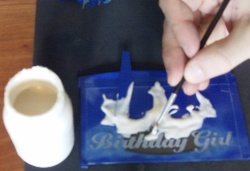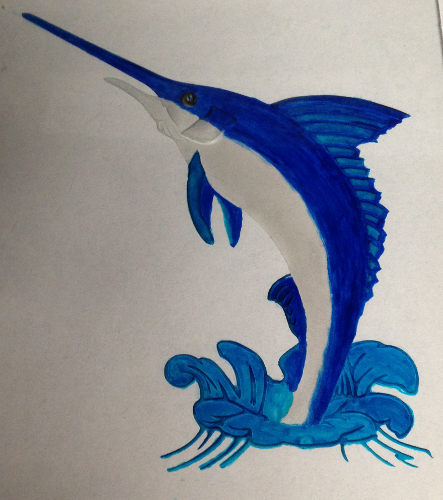I just got a recent email from a man named Johnny who wanted to ask me some questions about this hobby. I appreciate any questions, and you can leave me comments on this blog as well. I figured I would share it here because other crafters might have the same questions. So here’s his questions (some of them pertaining to using cream with cursive writing) and my answers:
How smoothly does the cream or acid flow? – The cream is rather thick, and has a high viscosity so it doesn’t flow like a water or anything. I actually chose not to work with the acid, but I think it flows more easily and has a lower viscosity. If I am wrong, then someone leave me a comment. If you are working with the strong chemical, then I recommend you take all the proper safety precautions. Read about it before using it; it’s very dangerous. Visit the acid etching page (www.glassetchingsecrets.com/acid.html) to get some other information on it.
- Do I need any special kind of brush or will any fine tip paint brush stand up to the chemical?– If you’re just using the regular craft cream, then you don’t need a special kind of brush. Some people use foam brushes and others use regular brushes. So yes, a fine tip brush will work, but if your doing freehand cursive brushing, it may be hard or unachievable to make the cream follow precisely with your strokes (due to being thick and all). I personally haven’t tried it, so let me know if it does work. Either way, it won’t work as perfectly desired.
- Can the brushes be cleaned and reused?– Yes, definitely. You can just wash the cream off the brush with water.
- Can it be thinned with anything?– I might have to look back at some chemistry books (lol) to find out what it can be thinned with. I actually don’t know this and it’s a good question. One thing that I would like to say is, if you can thin it, the glass may not etch as well as the original thick cream. Diluting the cream any further would effect the potency of the chemicals. The chemicals required to etch it are fairly diluted already. But it’s worth a try on a scrap piece of glass, and I would be happy to hear if it was successful or not.
- How long does it take to etch before removing it?– I think it varies on the brand, but it usually takes about 5 minutes. You can see my previous post about the main etching cream brands sold (glassetchingsecrets.com/blog/glass-etching-kit/).
To answer your other questions, I don’t as of now sell the acid or cream on my site. Maybe someday though. There are a few places that sell it on the Internet, and I listed a few places of where to buy it at the bottom of this page. Personally, I buy mine on ebay but don’t use it often because I love to sandblast the glass. Thanks for your questions, and feel free to ask me anything here, as well as others.
Share this on social media or email by clicking below!

 How smoothly does the cream or acid flow? – The cream is rather thick, and has a high viscosity so it doesn’t flow like a water or anything. I actually chose not to work with the acid, but I think it flows more easily and has a lower viscosity. If I am wrong, then someone leave me a comment. If you are working with the strong chemical, then I recommend you take all the proper safety precautions. Read about it before using it; it’s very dangerous. Visit the acid etching page (
How smoothly does the cream or acid flow? – The cream is rather thick, and has a high viscosity so it doesn’t flow like a water or anything. I actually chose not to work with the acid, but I think it flows more easily and has a lower viscosity. If I am wrong, then someone leave me a comment. If you are working with the strong chemical, then I recommend you take all the proper safety precautions. Read about it before using it; it’s very dangerous. Visit the acid etching page (


thanks eric, great info. great site, too. i think i may rethink my design. your beer glass labeled “Abrasive Etched Pilsner Beer Glasses” gives me an idea. if i treat it like a negative and etch the background i don’t have to be so neat with the cream, only with my exacto knife on masking skills. (infact that seems less stressful too)
johnny
Johnny, thanks for your nice comments. You got the right idea, exaclty. Thats why glass etching is so interesting to me. You can do alot of different things such as etching the negative. I hope that helps and feel free to let me know about it when its done.
HOLA , ESCRIBO DESDE ESPAÑA, HAY ALGUN DISTRIBUIDOR DE LA CREMA DE ACIDO AQUI EN ESPAÑA?
No estoy muy familiarizado con la distribución de la crema de grabado en España. Si los buques Amazon.com allí, podría intentar esta empresa. Estoy seguro de que hay algunos lugares. Tal vez incluso probar su tienda local de la manía.
hey, i know it says about thinning, but if it was thinned, would it be able to be placed in a marker? if so, do you have any other info on thinning?
Can you tell me why some glass will not etch? Thank you!
Is there an explanation why some glass will not etch. I am using the etching cream Armour Etch. Thank you!